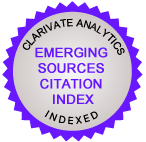Between Najat El Hachmi and Said El Kadaoui Moussaoui: from belongingness as a scar to identity as transgression
-
Abdelkader Bousfanj
 abdelkader.bousfanj@gmail.com
abdelkader.bousfanj@gmail.com
Downloads
Abstract
One of the spaces of expression where the question of identity arises with greater acuity is literature. In the case of the Mediterranean, literature or literatures are born from the encounter of texts and worlds, that is, the production of texts, their dissemination and their reading contribute to the creation of a world. As an imaginative and symbolic space, literature, and novel in particular, offers the possibility of a fruitful dialogue with identity in all its components. Literature, through its own procedures, articulates and discusses, under the most diverse forms, the real, emphasizing in man, his experiences, his hopes, his ambitions, his phantasms, his fears and his visions. And this is precisely the context that we are going to locate ourselves in for the study of the sketched representation of identity in two novels: La hija extranjera (2015) by Najat El Hachmi (Nador,1979), translated from Catalan La filla estrangera and NO (2016), also translated from Catalan, by Said El Kadaoui Moussaoui (Nador, 1975). Both authors are part of a batch of writers from the Moroccan Rif, that as a sample of its adaptation to Western / Spanish symbolic canvas, Catalan in this case, have been laying, over the past few years, the basis for an archetypal scriptural project, focused on reflection on belonging and identity. We propose to contribute, here, a reflection on how this identity singularity is modeled, located between two topographies and two chronographies, paying special attention to the particularity that the discourse here uttered about the identity is carried out not from the vernacular but from the adoption language.
Palabras Clave
CALVINO, I. (2014). Lecciones americanas, Seis propuestas para el próximo milenio (Traducción de Aurora Bernárdez y César Palma). Madrid: Siruela.
CANIVEZ, P. y COULOUBARITSIS, L. (coords.) (2013). L'Ethique et le soi chez Paul Ricoeur: Huit études sur Soi-même comme un autre. Villeneuve d'Ascq: Presses Universitaires du Septentrion.
EL HACHMI, N. (2015). La hija extranjera. Barcelona: Destino.
EL KADAOUI MOUSSAOUI, S. (2016). No. Barcelona: Catedral.
JERVOLINO, D. y RICOEUR, P. (2002). Une herméneutique de la condition humaine. Paris: Ellipses.
KHATIBI, A. (1971). La mémoire tatouée. Paris: Denoël.
KILITO, A. (2000). La querelle des images. Casablanca: Eddif.
KUNDERA, M. (1995). L‘art du roman. Paris : Gallimard.
MATEO DIEZ, L. (2001). ABC.es, Cultura en: http://www.abc.es/hemeroteca/historico-16-04-2001/abc/Cultura/luis-mateo-diez-en-el-sillon-de-la-real-academia-me-sentire-ciudadano-de-celama_24583.html
PROUST, M. (1987). Le temps retrouvé. A la recherche du temps perdu. Paris: Gallimard.
RICOEUR, P. (2006). Sí mismo como otro. Mardid: Siglo XXI Editores.
ROBÍN, R. (2003). Le deuil de l‘origine: une langue en trop, la langue en moins. Paris: Kime.
YETIV, I. (1972). Le thème de l‘aliénation dans le roman maghrébin d‘expression française, 1952-1956. Sherbrooke (Québec): Faculté des Arts C.E.I.F.F.
Similar Articles
- Hajar Benmakhlouf, Driss Ouldehaj, Artificial intelligence and literary translation: reality and prospects , Perspectivas de la Comunicación: Vol. 18 (2025): (Publishing on a rolling basis)
- Giovanna Gianturco, Francesca Colella, Identity, otherness, interculture: conceptual orientations between stereotypes and social imaginary , Perspectivas de la Comunicación: Vol. 15 No. 2 (2022): July - December
- Delia Crovi Druetta, Communication, interaction and dialogue. Contributions from Latin America to Educommunication [Bilingual edition: Spanish – English] , Perspectivas de la Comunicación: Vol. 11 No. 2 (2018): September - December
- José Luis Torres-Martín, Andrea Castro-Martínez, Pablo Díaz-Morilla, Cristina Pérez Ordóñez, Women executives and creators in the audiovisual sector. Analysis of Spanish fiction series in the catalogs of Amazon Prime Video, Movistar+, and Netflix (2019-2021) , Perspectivas de la Comunicación: Vol. 15 No. 2 (2022): July - December
- Minerva Yoimy Castañeda Seijas, The city as the scene of dialogue. Notes from intercultural communication. , Perspectivas de la Comunicación: Vol. 10 No. 2 (2017): Setiembre - Diciembre
- Philippa Jane Page, Re-imagining Europe: local imaginaries, affect and the ever-thorny question of a continental identity [Bilingual edition: Spanish – English] , Perspectivas de la Comunicación: Vol. 11 No. 1 (2018): january - august
- Azeddine Ettahri, El contacto lingüístico hispano-rifeño: sus situaciones, motivaciones y consecuencias , Perspectivas de la Comunicación: Vol. 8 No. 2 (2015): Setiembre – Diciembre
- Miguel Alejandro Chamorro Maldonado, Discourse semiotics of historical memory on the internet. Traces of memories in Chilean and Spanish fiction series and their convergence with social networks , Perspectivas de la Comunicación: Vol. 11 No. 2 (2018): September - December
- Sebastián Gago, Memory construction in the new River Plate historical comic: the case of Malandras and Tacuara (Santullo-Ginevra) , Perspectivas de la Comunicación: Vol. 14 No. 2 (2021): July - December
- Carolina Mazzetti Latini, Between humor and taboo. Death in the communicational plot. , Perspectivas de la Comunicación: Vol. 14 No. 2 (2021): July - December
You may also start an advanced similarity search for this article.
Downloads
Published
How to Cite
Issue
Section
License
- Proposed policy to offer Open Access Journals
Authors who publish with this journal agree to the following terms:
a) Authors retain copyright and grant the journal right of first publication with the work simultaneously licensed under a Creative Commons Attribution Attribution (CC -BY 4.0) ![]() that allows others to share the work with an acknowledgement of the work's authorship and initial publication in this journal.
that allows others to share the work with an acknowledgement of the work's authorship and initial publication in this journal.
b) Authors are able to adopt licensing agreements for the non-exclusive distribution of the journal's published version of the work (for example, to post it to an institutional repositories or publish it in a monograph), with an acknowledgement of its initial publication in this journal.
c) Authors are allowed and encouraged to post their work online (For example, in institutional repositories or on their website) prior to and during the submission process, as it can lead to productive exchanges and increase the citation of published work (See The Effect of Open Access).











